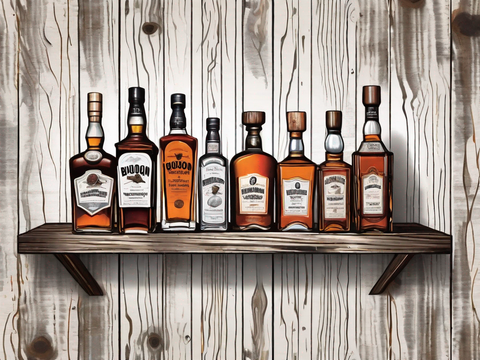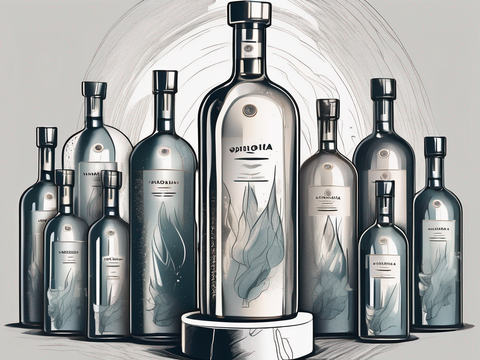When it comes to celebrating special occasions or simply indulging in a glass of bubbly, Champagne may be the first wine that comes to mind. However, the world of sparkling wines goes far beyond the boundaries of the Champagne region in France. Alternative sparkling wines have been gaining popularity in recent years, offering diverse styles and flavors that are worth exploring. In this article, we will dive into the basics of sparkling wines, the rise of alternatives, the different styles available, how to identify unique characteristics through tasting notes, and finally, how to pair these delightful wines with food.
Understanding the Basics of Sparkling Wines
Before we delve into the world of alternative sparkling wines, it's important to understand the fundamental production methods that give these wines their signature effervescence. While there are various techniques used, two of the most common methods are the Traditional Champagne Method and the Charmat Method.
The Traditional Champagne Method
The Traditional Champagne Method, also known as Méthode Champenoise, is the process used to produce Champagne. It involves a second fermentation in the bottle, where a mixture of yeast and sugar is added to the base wine. This creates carbon dioxide, which is trapped in the bottle and ultimately gives the wine its characteristic bubbles. The wine is then aged on its lees, the spent yeast cells, to develop complex flavors before being disgorged and finally corked.
The Charmat Method
Unlike the Traditional Champagne Method, the Charmat Method involves a second fermentation that takes place in pressurized tanks rather than individual bottles. The wine undergoes the second fermentation with added yeast and sugar, just like in the Traditional Method. However, the Charmat Method allows for a quicker production process, resulting in wines that are typically fruitier and fresher in style.
The Rise of Alternative Sparkling Wines
While Champagne has long been revered as the king of sparkling wines, alternative sparkling wines have been steadily gaining traction in recent years. There are several factors driving the popularity of these alternatives, including changing consumer preferences and the desire for more accessible price points.
Factors Driving the Popularity
One of the key factors driving the popularity of alternative sparkling wines is their affordability. While Champagne can often come with a hefty price tag, alternative sparkling wines offer a more budget-friendly option without compromising on taste and quality. Additionally, consumers are increasingly seeking out unique and lesser-known wine regions, which has led to the rise of alternative sparkling wines from countries such as Italy, Spain, and Germany.
Key Regions Producing Alternative Sparkling Wines
Italy's answer to Champagne is Prosecco, a sparkling wine produced primarily in the Veneto region. Prosecco is known for its delicate flavors, floral aromas, and light, refreshing character. Spain, on the other hand, has its sparkling star in the form of Cava. Produced using the Traditional Method, Cava offers a wide range of styles, from crisp and citrusy to richer and more complex. Germany's sparkling secret is Sekt, which showcases the country's exceptional cool-climate vineyards in a sparkling expression. Sekt can be crafted using either the Traditional Champagne Method or the Charmat Method, resulting in a spectrum of styles to suit different preferences.
Diverse Styles of Alternative Sparkling Wines
The world of alternative sparkling wines is incredibly diverse, offering a wide range of styles and flavors to suit every palate. Let's explore a few notable examples:
Prosecco: Italy's Answer to Champagne
Prosecco, with its vibrant and lively character, has become a beloved sparkling wine worldwide. Its primary grape variety is Glera, which imparts fresh and fruity flavors such as green apple, pear, and lemon. Prosecco is typically produced in a dry or extra-dry style, making it a versatile choice for both sipping on its own and pairing with a variety of dishes.
Cava: Spain's Sparkling Star
Cava, produced in the Penedès region of Spain, offers a delightful alternative to Champagne. Made from a blend of indigenous Spanish grape varieties such as Macabeo, Parellada, and Xarel·lo, Cava showcases a wide range of flavors and styles. From crisp and citrusy to toasty and nutty, there is a Cava to suit every taste preference.
Sekt: Germany's Sparkling Secret
Sekt, Germany's sparkling wine, has been gaining recognition for its high quality and diverse styles. Produced using a variety of grape varieties, including Riesling and Pinot Noir, Sekt offers a unique expression of Germany's cool-climate terroir. Whether you prefer a bone-dry Sekt or a sweeter style, you can find a Sekt that aligns perfectly with your palate.
Tasting Notes: Identifying Unique Characteristics
When tasting sparkling wines, it's important to pay attention to the different flavor profiles and unique characteristics that each wine offers. Here are some key elements to consider:
Flavor Profiles of Different Sparkling Wines
The flavor profiles of sparkling wines can vary greatly depending on factors such as grape varieties, production methods, and aging. Champagne, for example, often exhibits complex aromas of citrus, toast, and brioche, with a fine and persistent mousse. Prosecco, on the other hand, tends to showcase lighter and fruitier flavors, with notes of green apple, pear, and white flowers. Exploring different sparkling wines allows you to discover a wide array of flavors and aromas.
The Role of Grapes and Terroir
Just like still wines, the grapes used in producing sparkling wines and the terroir in which they are grown play a significant role in shaping the final product. The choice of grape varieties can contribute to the wine's acidity, fruitiness, and overall flavor profile. Additionally, the characteristics of the terroir, such as soil composition and climate, can impart unique nuances and minerality to the wines. Exploring different grape varieties and regions will unveil a world of diverse sparkling wine experiences.
Pairing Alternative Sparkling Wines with Food
Pairing sparkling wines with food can elevate both the wine and the culinary experience. Whether you're enjoying a glass of sparkling wine with a meal or creating a festive pairing for a celebratory occasion, consider these tips:
Best Food Combinations for Each Wine Type
When it comes to food and wine pairing with sparkling wines, the general rule of thumb is to match the weight and intensity of the food with the wine. Light and delicate Prosecco pairs wonderfully with fresh seafood, appetizers, and light salads. Cava, with its versatility, can accompany a wide range of dishes, including tapas, grilled fish, and creamy cheeses. German Sekt, depending on the style, can be enjoyed as an aperitif or paired with rich and flavorful dishes such as roast pork or spicy Asian cuisine.
Tips for Successful Wine and Food Pairing
To ensure a successful wine and food pairing, consider the following tips:
- Balance flavors: Consider the dominant flavors in both the food and the wine, aiming for complementarity rather than overpowering one another.
- Consider texture: The texture of both the food and the wine should work harmoniously together. A light-bodied wine, like Prosecco, pairs well with light and delicate dishes, while a fuller-bodied sparkling wine, like Cava, can handle heartier fare.
- Experiment and have fun: Don't be afraid to try new combinations and explore your own personal preferences. Wine and food pairing is subjective, so trust your taste buds and enjoy the journey.
As you embark on your journey of exploring alternative sparkling wines, keep an open mind and allow your senses to guide you. From the traditional Champagne Method to the various styles of Prosecco, Cava, and Sekt, the world of alternative sparkling wines offers a universe of flavors and experiences waiting to be discovered. Whether you're celebrating a special occasion or simply looking to enhance your everyday dining, these delightful sparkling wines are sure to add a touch of effervescence to your glass.




